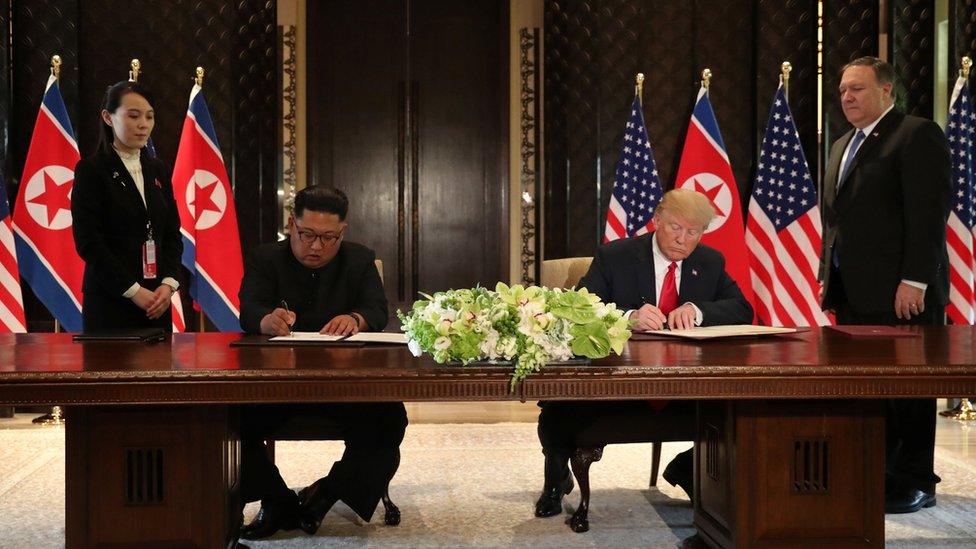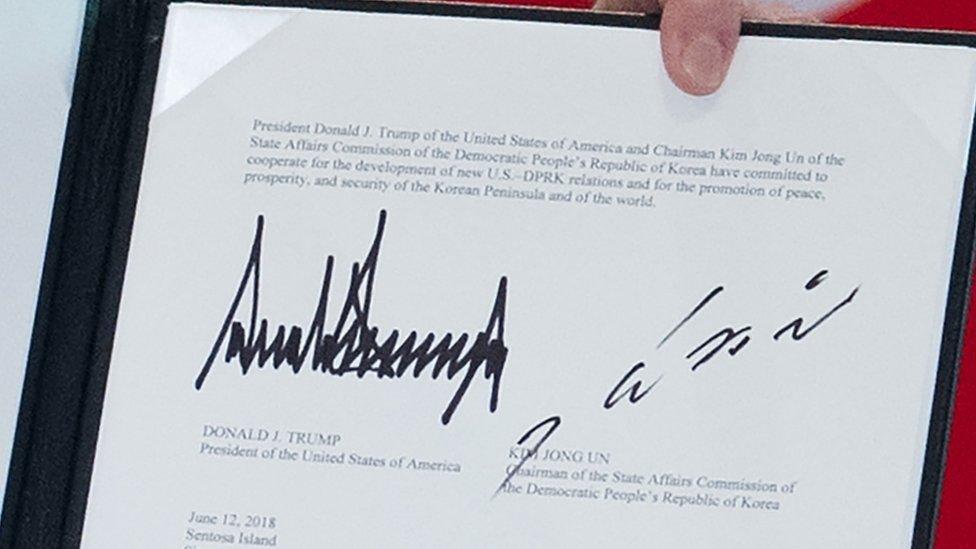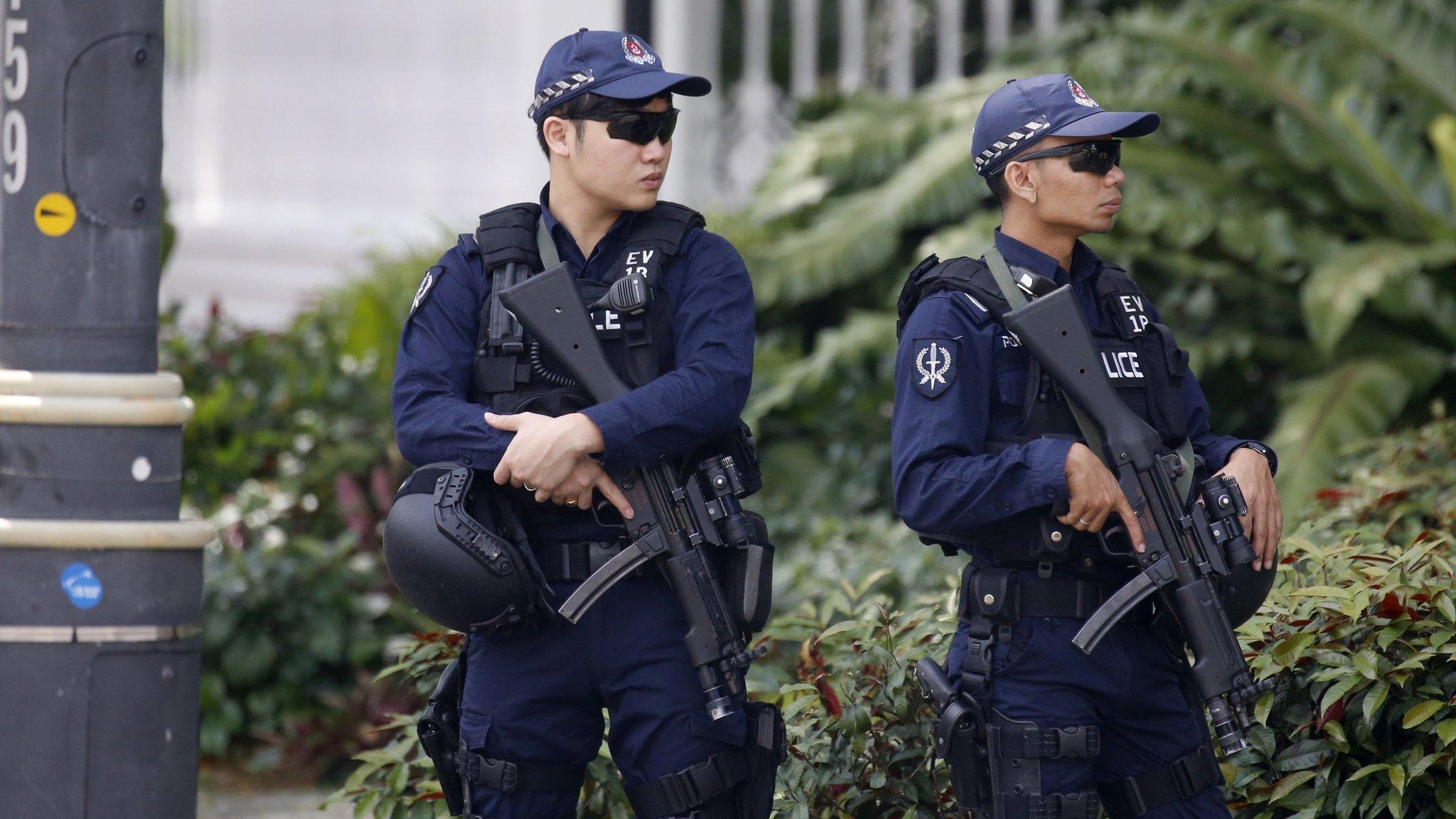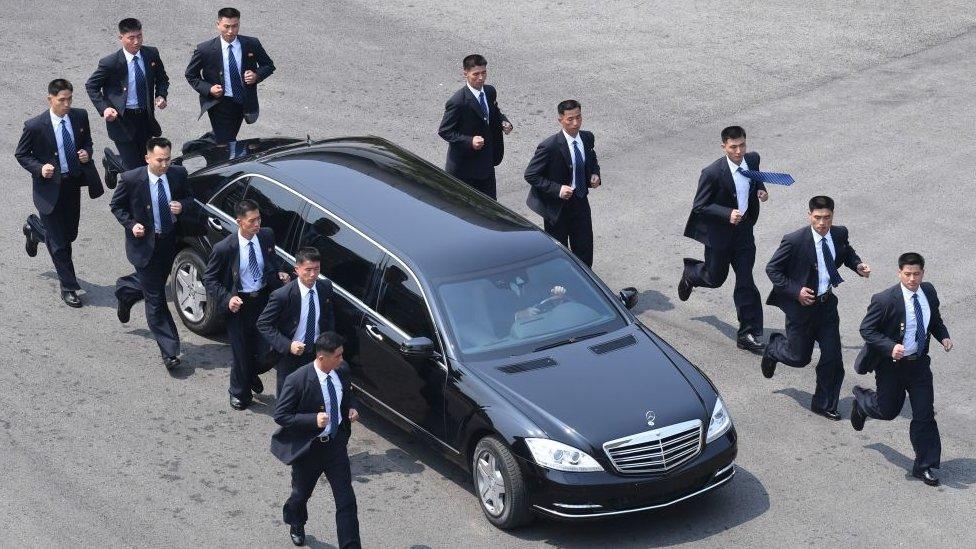Trump Kim summit: US and North Korean leaders hold historic talks
- Published
Trump Kim: The moment they shook hands
Donald Trump and Kim Jong-un have become the first sitting US president and North Korean leader to meet, an unprecedented development after a year of exchanging threats.
The pair shook hands at a luxury hotel on Singapore's Sentosa island before proceeding to talks.
After the summit the leaders signed a "comprehensive" document, promising a new relationship between the nations.
They had been discussing defusing tensions and nuclear disarmament.
The document commits North Korea to work towards "the complete denuclearisation of the Korean peninsula" and promises "new relations" between Washington and Pyongyang.
The US had demanded "complete, verifiable and irreversible denuclearisation".
There was also a commitment to build "a stable and lasting peace" on the Korean peninsula.
"I think both sides will be very impressed with the result," Mr Trump said at a signing ceremony with Mr Kim.
The US president said more details would be provided at a press conference due shortly.

Mr Trump said his meeting with Mr Kim went "better than anybody could have expected"

The pair signed a document pledging they would work towards new relations
Mr Trump spoke of a "special bond" with the North Korean leader and said he was "absolutely" willing to invite him to the White House.
"We've decided to leave the past behind," Mr Kim said. "The world will see major changes."
Still, analysts remain divided on what the summit will ultimately achieve. Some see it as a propaganda win for Mr Kim, others a potential path to peace.

Details are thin - but it's a start
Analysis: Laura Bicker, BBC News, Singapore
The agreement the two sides have signed is vague and lacking in detail. It only commits the US and North Korea to the denuclearisation of the Korean peninsula.
There is no mention that the process should be verifiable or irreversible - which is what the US has been pushing for. There is no timetable to disarm North Korea nor is there any invitation for weapons inspectors to be allowed in.
The US has said it will provide security guarantees without specifying what that might mean - or if that could involve the removal of some American troops based in South Korea. The two sides have promised to hold follow up talks and work on efforts to build a lasting peace regime.
This could eventually result in a treaty to end the near 70-year war. It is at least a start. Something to build on.

How the historic moment unfolded
The summit began with a striking image, unimaginable just months ago.
The two men walked towards each other and firmly gripped each other's hands in front of US and North Korean flags.
Mr Trump patted Mr Kim's arm as they stood on red carpet and exchanged a few words before turning to face the gathered press.
"I feel really great. We're going to have a great discussion and will be tremendously successful," the US president said.
Sitting alongside each other, ahead of a one-on-one meeting, the pair appeared relaxed against the odds.
Trump: 'It's my honour'
"It was not easy to get here," Mr Kim said. "There were obstacles but we overcame them to be here," and his counterpart responded "That's true."
The two men, accompanied only by interpreters, spoke for a little under 40 minutes. They were then joined by small delegations of advisors for a working lunch.
From Washington the group included US Secretary of State Mike Pompeo and security adviser John Bolton, and on Pyongyang's side, Mr Kim's "right-hand man" and former spy chief Kim Yong-chol, and foreign minister Ri Yong-ho.
Over lunch they shared a mix of Western and Korean dishes, including stuffed cucumbers and Daegu jorim, a soy-braised fish dish.
Trump-Kim summit: The view from South Koreans
What does this mean for each man?
The unprecedented event carries great potential prestige for each leader - but also, in the long run, a possibly catastrophic loss of face.
For the moment Mr Trump will credit any successful outcome of talks to his "maximum pressure" campaign on North Korea, that tightened economic sanctions and threatened military action. Many believe that no matter what is achieved this will be the narrative.
For Mr Kim, securing a stage with the US leader is seen as a victory in itself, something which neither his father or grandfather could achieve.
Such a meeting has long been seen as a prize in the eyes of North Korea for the legitimacy it would confer on its leader.

The leaders walk together at the Capella hotel in Singapore
Kim's journey from outcast to statesman
For decades, North Korea has been a pariah state, and now its latest hereditary leader is being treated as a world statesman.
Last year, it would have been a rare sight to see a North Korean flag flying anywhere in Asia.
Now, Mr Kim - who runs a totalitarian regime with extreme censorship and forced-labour camps - is meeting and greeting dignitaries.
On the eve of the summit, Mr Kim toured Singapore's tourist sites, waving to excited crowds and snapped a selfie with the city state's foreign minister.
Tuesday's front page of North Korea's official newspaper featured the extraordinary scenes on display in Singapore, offering many in the country an unprecedented glimpse of their leader in a setting utterly at odds with their daily life.
Kim Jong-un toured the Marina Bay Sands hotel in Singapore
How did we get here?
This is an outcome that seemed unimaginable less than a year ago - when Mr Trump and Mr Kim exchanged streams of fiery insults - and North Korea conducted several ballistic missile tests in defiance of the international community.
Mr Trump famously vowed to unleash "fire and fury" if Pyongyang kept threatening the US. Meanwhile, Mr Kim has called Mr Trump "mentally deranged" and a "dotard".
But earlier this year North Korea showed a new openness to diplomacy and held direct talks with Seoul. The rapid improvement in relations between the North and South Korea - technically still at war - culminated with a historic leaders' summit in April.
The nuclear word Trump and Kim can't agree on
During this warming of relations between the two Koreas, Mr Trump stunned the world by accepting an invitation to meet Mr Kim.
- Published12 June 2018

- Published11 June 2018

- Published11 June 2018

- Published21 April 2020

- Published6 June 2018
